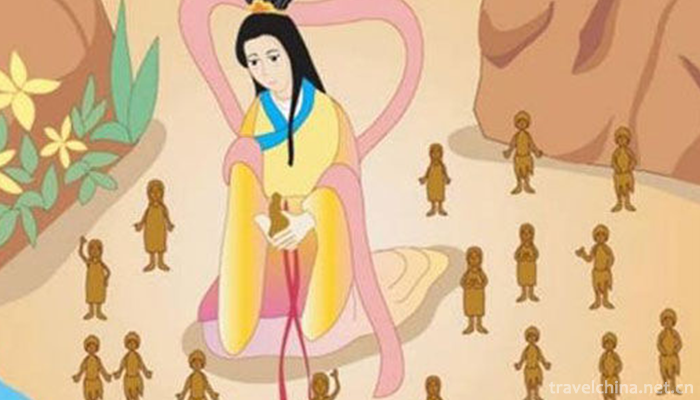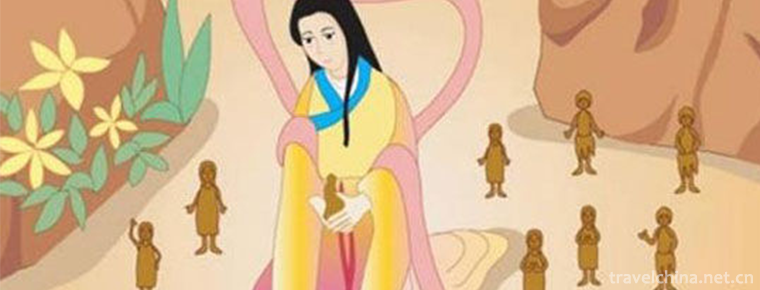Shaoyuan mythological group
Shaoyuan mythological group
Shaoyuan myth group is one of the ancient Chinese myths and legends. Refers to the general name of the creation myths and mythological prototypes circulated in Shaoyuan Town, Jiyuan City, Henan Province. Since ancient times, stories such as Nuwa have been circulating in Shaoyuan. In the north of Zhenzhou, there are Heilongshan, Aobeishan, Suoquanling, which is located at the four poles of the broken Aozuo foot, Suoquanling where the lime is locked up, and Yinhe Gorge where the stone is refined to fill the sky, as well as ancient place names, cultural relics and ancient relics. The rich content of Shao Yuan's myth of creation reflects the relationship between people and nature, people and society, people and people, and people themselves, as well as contradictions, conflicts and struggles. It is harmonious in the process of unity of opposites and accumulates the national humanistic spirit.
On June 7, 2008, the "Shaoyuan Myth Group" declared by Jiyuan City, Henan Province, was approved by the State Council and listed in the second batch of national intangible cultural heritage list.
historical origin
Shaoyuan Town, Jiyuan City, Henan Province, is located at the junction of Henan and Jin Dynasties in the northwest of Henan Province, north of the Taihang, Wangwu and Zhongtiao Mountains inhabited by primitive human ancestors; south of the Yellow River, the mother river of the Chinese nation, covering an area of 337 square kilometers, with 40,000 people, it spans 112 112 10', and 35 10'- 35 According to the research of human scientist, the area around 35 degrees north latitude is most suitable for human survival and development. The geographical location and environment of Shaoyuan area in the ancient Chinese people determine that it must be the origin of the creation myth. Peiligang cultural sites 7,000 years ago and Yangshao and Longshan cultural sites 5,000-4,000 years ago have been found in the territory. They have abundant human landscape resources and unique natural conditions. They are full of Qifeng and Junling mountains, rivers and rivers, green mountains and clear waters, and pleasant environment. They are places where the ancestors of China thrive and thrive. Shaoyuan has complex geological structure, unique geomorphology, rich content of Kaitian myths and legends, and clear outline of natural prototypes. Shaoyuan has a long history of history and culture. Shaoyuan is an ancient and magical place where the creation myth of China originated.
(Source of Shaoyuan Mythological Group Prototype Atlas: )
Shaoyuan is an ancient town with a history of more than 7000 years. Even if there are written records, it has a history of more than 3000 years. With the change of administrative divisions, there are many names in history, such as Zhao, Shao, Shao, Shao, Shao, Shao, Shao, Shao, Shao, Shao, Wangwu, Shao and so on. The story of Nuwa has been handed down since ancient times. There are famous mountains and rivers in the north of Zhenbei, such as Heilongshan, which has been chopped off by the evil dragon, Aobeishan which stands at the four poles, Suoquanling where the ashes are locked up, and Galactic Gorge where the stone is refined to fill the sky, all of which are the prototypes of "Nuwa Butian". They are large-scale and naturally formed. The image is lifelike and the system is complete, which is the only one in the country. Many experts and scholars have examined and certified that the original place of Nuwa myth is the ancient Shaozhou area centered on Shaoyuan Town, Jiyuan City. There are many myths about Nuwa in Shaoyuan and its surrounding areas. They are relatively concentrated and face the whole country directly. They are not available in other places. The ancient place names, cultural relics and relics scattered on the land of Shaozhou fully prove the opinions of experts and oral biographies. From the geographic and geographic point of view, Shaoyuan is located in Taihang in the north, with the middle strip as the barrier, and the Yellow River lingering in the south, facing the towering Funiu Mountain. In the east, the Temple of Heaven is very beautiful, while in the west, Zhong Ling of the Three Jin Dynasty belongs to the shallow loess hilly belt with a radius of 50 li. In the 26th year of Qianlong reign of the Qing Dynasty (1761 A.D.), Ling Xiaoying-zhi of Jiyuan County visited Shaoyuan, which was shocked by the scene. He wrote poems: "Taihang West and Chenglian, with a glimpse of Emei Wangang hanging. Shanjingyao Tong Jinshuiqu, Yanguan Shensuoling Yunxuan. It is this hot land that breeds ancient ancestors and Chinese culture. In the battle against natural disasters, we successively weave fantastic myths of creation with extraordinary imagination to show the grandeur and high wisdom of the battle between heaven and earth.
Inheritance Significance
The rich content of Shao Yuan's myth of creation reflects the relationship between people and nature, people and society, people and people, and people themselves, as well as contradictions, conflicts and struggles. It is harmonious in the process of unity of opposites and accumulates the national humanistic spirit.
Shao Yuan-shi's myth is known as "aesthetic" myth, which has the charm of moralization, ethics and philosophy. Shao Yuan-shi's mythology has profound humanistic connotations and inherits philosophical thoughts from ancient to modern times. Pangu and Nuwa, as the ancestors and heroic images of the Chinese nation, contain the spirit of pioneering, pioneering, innovative, fearless, forward, self-improvement and continuing to forge ahead; their virtues of dedication, incarnation, willingness to sacrifice; their noble qualities of benefiting mankind, punishing evil and promoting good, putting people first, and protecting the people; their self-improvement and self-reliance; The spirit of faith, self-diligence and self-love is of great value to the formation and enrichment of humanistic spirit in China, and plays a role in promoting the consciousness of national culture. The rich cultural capacity of Jiyuan Shao's original mythology group will surely bring forth new brilliance with the times and become the spiritual and cultural wealth shared by the Chinese nation. Shaoyuan is a natural relic of Chinese creation culture, and it is extremely precious. To study the myth group of Shaoyuan creation is of great significance to enhance national self-confidence and cohesion.


-
1.Hongtong Dahuaishu Ancestor Memorial Garden
Located in Hongdong County, Shanxi Province, Hongdong Dahuashu ancestor-seeking scenic spot is the only national sacrificial site with the theme of "root-seeking" and "ancestor-sacrific
Time 2018-11-24 -
2.Guangxi Medicinal Herb Garden
Guangxi Medicinal Botanical Garden is located in Xiangzhu Avenue, Nanning City, Guangxi Zhuang Autonomous Region. It was founded in 1959 and covers an area of 202 hectares
Time 2019-01-13 -
3.Bo Ba Shen en
Bobassengen is a unique folk large-scale narrative mass pot village dance created by Ganbao Tibetan Village in Jiarong Tibetan area, Lixian County, Sichuan Province. "Boba"
Time 2019-04-04 -
4.Jia Jia Quan
Amaranth, also known as Amaranth, Amaranth hammer, one of the traditional Chinese boxing. It was founded by Mr. Junai Zhou (1724-1783) in Heshui County, Zhengzhou, in the reign of Qianlong in the Qing
Time 2019-04-16 -
5.Dragon Boat rap
Dragon boat rap, also known as "Dragon Boat", "Dragon Boat Song", "Dragon Island Song" or "Shunde Dragon Boat", is a popular form of folk art in the Pearl River
Time 2019-05-14 -
6.Mongolian Folk Songs
Mongolian folk songs are mainly divided into two categories: ritual songs and pastoral songs. Mongolian folk songs are famous for their magnificent voices and melodious tunes.
Time 2019-06-04 -
7.Wenzhou opera
Ou Opera has a history of more than 300 years with "written warmth" as its stage language. The more influential traditional plays are Gao Ji and Wu Sanchun, Yanghe Pickup and the modern play
Time 2019-06-08 -
8.Panwang Song
Panwang Song is a collection of Yao folk poetry. Mainly spread in the residential areas of the Yao nationality in Nanling Mountains, Jianghua is a folk literature with distinct national characteristic
Time 2019-06-08 -
9.Quyang stone carving
Quyang stone carving is an important part of folk art in Quyang County, Hebei Province. Since the Western Han Dynasty, Quyang stone workers have used marble to carve steles and other objects. Quyang s
Time 2019-06-11 -
10.Xingyiquan
Xingyiquan, also known as Xingyiquan, is one of the traditional Chinese boxing. Although there are different opinions on its origin, Ji Jike (1602-1680), a native of Puzhou, Shanxi Province, was widel
Time 2019-07-08 -
11.Yongkang Drum Ci
Yongkang Drum Ci is a rap art in Yongkang area of Zhejiang Province. It belongs to the form of singing and talking, which is mainly composed of singing. Because of the use of local dialect performance
Time 2019-07-14